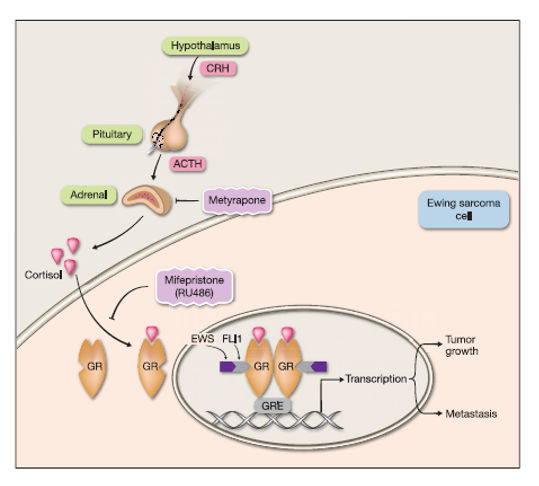Ewing sarcoma (ES) is a common bone malignancy in children and young adolescents which is usually treated by systemic chemotherapy. In about 25% of the cases, cancer has already spread to other parts of the body at the time of diagnosis. Here, we discover a novel family of ETS proteins that binds the glucocorticoid receptors and might retard cancer progression. This methodology can be used as an effective solution for Ewing Sarcoma's prognosis and treatment.
Ewing sarcoma is the second most common pediatric malignant bone tumor. Aggressive multimodality therapy has led to an improvement in outcomes, particularly in patients with localized disease. However, therapy-related toxicities are non-trivial and the prognosis for patients with relapsed and/or metastatic disease continues to be poor. The disease is driven by fusion between EWSR1 and with ETS (E26 transformation-specific) genes, either FLI1 or ERG 1. As much as the function of these fusion oncogenes is known in this particular cancer, so far, they have been proven to be undruggable. Therefore, only local treatments and systemic chemotherapy are being used as Ewing sarcoma treatments.
Prof. Yosef Yarden and his team discovered that the glucocorticoid receptor (GR) binds to ETS family members, consequently promoting ES progression. Therefore, inhibiting this interaction using clinically approved modulators of Glucocorticoid signaling might impair the progression of ES cancer.
The glucocorticoid receptor (GR) acts as a cortisol-dependent transcription factor (TF). Using protein-fragment complementation assays, the team found that GR recognizes FLI1 and additional ETS family TFs, which execute proliferation/migration signals. Following steroid-dependent translocation of FLI1 and GR to the nucleus, the FLI1-specific (FLS) domain binds with GR's hinge and DNA-binding domains. Furthermore, GR's transcriptional activity is significantly enhanced once it binds FLI1. The physical interaction of ERG and FLI1 fusions with GR increase the ability of GR-induced oncogenic signaling. Moreover, a GR-based gene signature correlated with poor survival of ES patients. Therefore, using clinically approved modulators of Glucocorticoid signaling might impair the progression of cancers which are mediated by ETS fusion protein.

Figure 1: The usage of GR antagonist, RU486, or a cortisol-lowering drug, Metyrapone, leads to retarded tumor growth and metastasis of Ewing sarcoma.
- Ewing sarcoma prognosis and treatment.
- Inhibits Ewing sarcoma and prostate cancers by already approved GR-targeting drugs.
Prof. Yarden and his team demonstrated physical interactions between the EST proteins, specifically the FL1 fusion protein, and the glucocorticoid receptor (GR). They further showed that in vitro, GR knockdown weakened cellular migration and proliferation, and in animal models antagonizing GR or lowering cortisol retarded the progression of Ewing sarcoma.
References:
1. Arnaldez, F.I., and Helman, L.J. (2014). New strategies in Ewing sarcoma: lost in translation? Clin. Cancer Res. 20, 3050–3056. doi: 10.1158/1078-0432.CCR-13-0633
.


